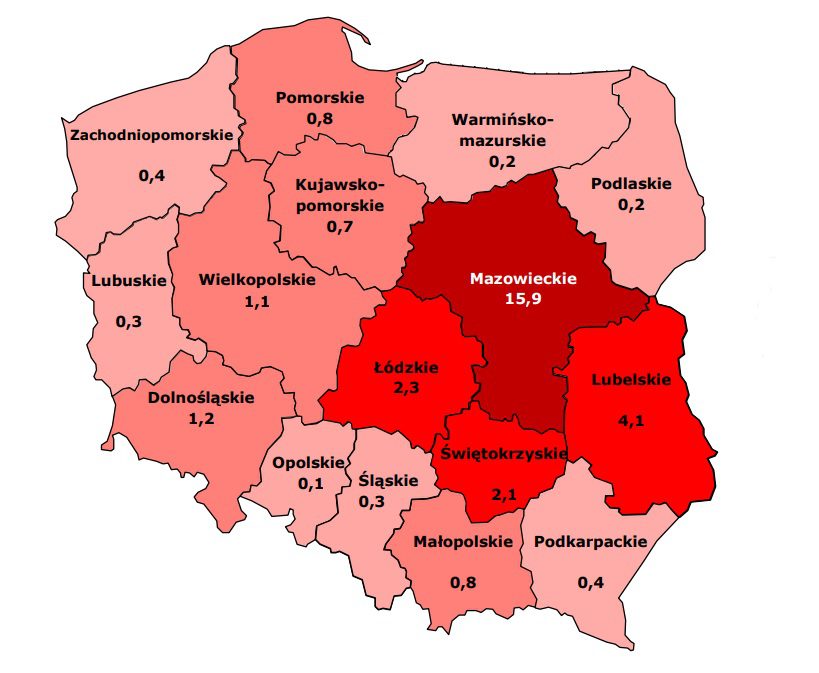From the farm to the table – traditional Polish strawberries
06.06.2024
The season for Polish superfruits begins in May. It is the Poles favorite fruit and the most awaited seasonal fruit. Poland, which is the second largest producer of strawberries in the European Union, supplies the market with huge quantities of these juicy fruit every year.

There are many varieties of strawberries grown in Poland, each of which has its own unique characteristics. Some of them, due to their unique qualities and historical significance for their region, have been included in the list of traditional products. Each of these varieties is valued for its specific properties, such as taste, texture, colour or history of cultivation in a given region. The inclusion on the list of traditional products emphasizes their cultural and economic importance and helps to protect and promote these unique varieties of Polish strawberries.
List of traditional products
In Poland, there are about 50 registered varieties of strawberries, which are characterized, among other things, by different times of bearing fruit. Among them, we have several varieties entered on the list of traditional products.
- Strawberries from the Kaszuby region
One of the most characteristic and valued varieties of Polish strawberries is the Kashubian strawberry, also known as “kaszëbskô malëna”. It received the European Protected Geographical Indication (COHG) certificate in 2009. This designation not only protects the name, but also guarantees that each batch of fruit meets stringent quality standards and comes exclusively from a specific region.
The microclimate of the Kashubian Lake District is characterized by significant daily temperature fluctuations, which translates into the exceptional taste of these strawberries. Cool nights and hot days are ideal for Kashubian strawberries, which are sweeter and have a more intense aroma compared to other varieties.
The fruits of the Kashubian strawberry are easily recognizable by their uniform, dark red colour and slightly shiny skin. They have a very thin skin on which the seeds can be felt. Their diameter usually exceeds 18 millimetres, and the taste often reminds one of wild forest strawberries.
- The Bielińska strawberry
The Bielińska strawberry, was included on the list of traditional products in the category of vegetables and fruits in the Świętokrzyskie Voivodeship in 2009, is a symbol of regional pride and tradition. Its cultivation in the Bieliny commune, which is part of the so-called “strawberry basin”, began in the 50s of the twentieth century. Initially, the ” Kartoflanka” variety was grown, which was not in high demand. However, already by the beginning of the 60s, with the increase in demand for soft fruit, the Bieliny commune became interested in the cultivation of the German strawberry variety “Sengi-Sengany”.
This fruit is characterized by a blood-red colour, firm texture and an intense, slightly sour taste. The Bielin strawberry, thanks to its unique taste and adaptation to the local, cool rock substrate, has become the driving force behind the economic development of the region. Its popularity is so great that it has become an inspiration for local poets and musicians, as well as the central element of the Świętokrzyska Strawberry Days, which every year attracts numerous lovers of this fruit.
- The Zwolen strawberry
The Zwolen strawberry, entered on April 20, 2021 on the list of traditional products, is an inseparable element of the local agricultural tradition in the Zwoleń district. It is known for its colour – orange-red, bright red to intense red, with a strong sheen. Strawberries from this region, initially grown on a small scale and sold before World War I, became widely recognized in Poland. In the 1960s, strawberries began to be transported by plane from Dęblin to the USSR. Czechs also started buying strawberries. At the beginning of the 50s, when the Horticultural Cooperative was reactivated, strawberries began to be accepted at collection points.
Strawberry cultivation is a deep-rooted tradition that has been passed down from generation to generation. The strawberry is at the forefront of cultivated agricultural products in the Zwoleń district, which is considered one of the largest strawberry producing areas in Poland.
- The Buska „faworytka”
The Buska strawberry, entered on the list of traditional products in 2007, is valued for its intense, characteristic taste with a slight hint of sourness and a strong red, almost burgundy colour. Grown on the fertile, loess soils of Busko-Zdrój, it is characterized by its firmness and silky, thin skin, which makes the fruit not only visually attractive, but also ideal for fresh consumption and processing.
The local microclimate, geographical location and traditional cultivation methods make this strawberry popular not only among locals, but also tourists visiting the region. It is present at many local events, being an element of the culture and gastronomic tradition of the Busk region. The history of strawberry cultivation in this location dates back to the 30s of the twentieth century, which makes it an important component of the cultural heritage of the region.
- Strawberries from the Puławy Commune
The strawberry from Puławy, entered on the list of traditional products in 2016, is a unique representative of the local flora in the Lublin Voivodeship. These strawberries, grown from varieties such as Honeoye, Darselect or Florence, are characterized by a conical, heart-shaped shape and a firm, juicy texture. The colour of the fruit ranges from light orange to intense dark red, and their taste ranges from very sweet to slightly acidic, which makes them extremely aromatic.
The tradition of growing these fruits in Puławy dates back to the beginning of the 20th century, and their importance increased in the 1950s with the development of the processing industry.
Production and export
Poland, as one of the leaders in strawberry production in Europe, harvested 1,994,000 tons of fruit in 2022. More than half of the 159,000 thousand hectares of strawberry acreage was located in the Mazowieckie Voivodeship, where more than half of the 982,000 thousand tons (53 percent) of the national production of these fruits was also harvested. Significant quantities of strawberries were also produced in the Lubelskie Voivodeship (330,000 thousand tonnes (18% share in the harvest), Łódź (131,000 thousand tonnes) (7%) and Świętokrzyskie (87,000 thousand tonnes) (5%). In total, the four above-mentioned voivodeships accounted for 79% of the strawberry cultivation area in Poland and for nearly 83% of the strawberry harvest in our country.
Regional variation in the area under strawberries in 2022 (in thousand ha)

According to KOWR’s analyses, a significant volume of the domestic strawberry harvest is exported. In the years 2014-2022, 50 to 70 percent of the domestic production of these fruits was sold abroad. According to data from the Ministry of Finance, in 2022, 88, 000tons of strawberries were exported from Poland (including 737,000 tons of frozen strawberries and 143,000 tons of fresh strawberries).
The export volume of fresh strawberries from Poland in 2023 amounted to 203,000 tonnes, and its value was PLN 134 million.
A significant part of the harvest is exported, mainly in the form of frozen fruit. In 2014–2022, 74–123,000 tons of frozen strawberries were exported from Poland annually, which accounted for 40–60 percent of the share in the domestic strawberry harvest. The largest recipient of frozen strawberries from Poland is the European Union. In 2022, 90 percent of the export volume of this product (66,000 tons) went to the Community. Frozen strawberries from Poland were exported mainly to Germany (23,000 tonnes), the Netherlands (11,000 tonnes) and France (9,000 tonne s). About 58 percent of the total volume of frozen strawberries was exported to these countries.
Festivals and traditions
Various festivals dedicated to strawberries are held in Poland, which are a unique opportunity to celebrate regional traditions, promote local products and integrate communities. These festivals combine cultural, gastronomic, and entertainment elements, which attract both local residents and tourists from different parts of the country.
The most popular Polish strawberry festivals:
The strawberry Harvest in Brodnica Górna – takes place annually at the beginning of July in Kashubia, presenting the achievements of Kashubian culture, as well as offering numerous stands with strawberries and handicrafts.
The Kashubian Strawberry Festival in Chmielno – promotes local traditions and delicacies in Kashubia, with a rich program of folklore and music.
The Świętokrzyska Strawberry Day – an event organized in the Świętokrzyskie region, which combines tastings of local strawberry varieties with elements of regional culture.
National Strawberry Days in Korycin – with the festival strawberry battle as the main attraction, which celebrates the popularity of these fruits by presenting products and culture from all over Poland.
The Strawberry Festival in Przyłęk – focuses on the promotion of the Zwoleń strawberry, entered on the list of traditional products, which emphasizes the long-standing tradition of growing these fruits in the region.
Each of these festivals has its own unique atmosphere and specifics, offering visitors a wide range of attractions, from artistic performances to themed competitions related to strawberries. These holidays not only facilitate the promotion of local strawberry varieties and strawberry products, but also serve as important events to support local economies and culture.
Polish strawberries are a product that we proudly present on the international arena. Their diversity, unique taste and quality make them unflaggingly popular both in Poland and abroad. Farmers in Poland grow a wide range of these fruits, from those popular on a global scale to local, traditional varieties that have been included in the list of traditional products. Strawberry festivals are a testament to the cultural significance of these fruits in Poland, attracting strawberry lovers from all over the country. These elements, together with the commitment to maintaining high standards of cultivation, make Polish strawberries valued by consumers for their quality and freshness.
Sources: The National Support Centre for Agricultural, Agricultural And Food Quality Inspection
Spis treściTable of contents
- Everything
- News (254)
- Events (159)
- Get Support (82)
-

TADEX BRACIA PIŁAT SPÓŁKA KOMANDYTOWA
Medical equipmentMachinery and parts thereofIndustrial machinery and mechanical appliances and parts thereofMeasuring instruments and apparatus and parts thereofAgricultural machinery and parts thereofElectromechanical appliances and parts thereofVehiclesAutomotive industryCombustion engines, motors and parts thereofLocomotives, rolling stock, special vehicles and parts thereofElectric engines and batteriesAerospace industryVehicle parts (excluding engines)Show allShow more Show lessTADEX BRACIA PIŁAT is a trusted European manufacturer of high-precision CNC turned components. With decades of experience and a modern machine park, we deliver custom-made parts based on client drawings and technical specifications. Our main products include bushings, pins, piston rods, connectors, and many others. We supply components to key industries such as automotive, HVAC, medical and rehabilitation equipment, hydraulic power systems, and gas installations for both vehicles and buildings.

EGIN CONSULTING MARCIN LEWICKI
Business servicesRenovation and construction materialsYachtsPolymers, resins and articles thereofOther goodsShow allShow more Show lessCurrently we are actively and successfully implementing our own products and innovative technologies. One of these has been shaped into the brand – ArtisHeat® – where technology has been already patented. We are also working on other ideas and patents, which will be commercialized on the market soon. See more details on: www.artisheat.pl/en

TECHWIND SPÓŁKA Z OGRANICZONĄ ODPOWIEDZIALNOŚCIĄ
Renovation and construction materialsYachtsIndustrial machinery and mechanical appliances and parts thereofShow allShow more Show lessTECHWIND company was established in 1987 and has been operating under its current name since 1991. Since the beginning of its existence, the company has been operating in the elevator industry. Initially, it was only the assembly of domestically produced elevators. Over time, the range of services and devices offered was expanded to keep up with market requirements. The company’s activities include production, delivery, assembly and service of lifting equipment.
-
 Article
ArticleTrade between the European Union and Poland with China in 2023-2024
The European Union and China are among the world’s most important trading partners
 Article
ArticleThe Polish economy and critical dependencies on imports
In 2023 Poland imported 321 categories of goods that can be considered crucial for the economy
-
 Event
EventKIELCE IFRE-EXPO 2025
The 5th International Trade Fair of Fire Brigade and Rescue Services Equipment will be held between …
 Event
EventElectronics Show 2025
The Electronics Show is the largest event for the household appliances, electronics and smart home s…
-
 Institution
InstitutionPolish Investment and Trade Agency (PAIH)
The Polish Investment and Trade Agency (PAIH) is the partner of first-resort for entrepreneurs when …
 Institution
InstitutionPolish Agency for Enterprise Development (PARP)
Polish Agency for Enterprise Development (PARP) mission is an implementation of economical developme…
The Export Promotion Portal uses cookies to make it easier for users to use the website and for statistical purposes. If you do not block these files, you agree to their use and saving in the memory of your computer or other device. Remember that you can change your browser settings to block the storage of cookies. More information can be found in Privacy Policy and Terms and conditions.





